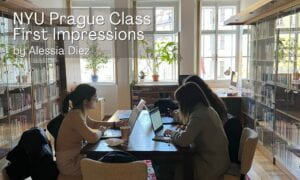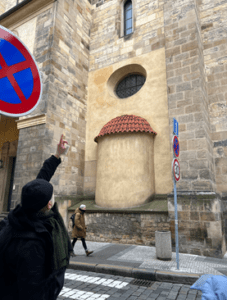
By Alessia Diez
During syllabus week, I shuffled between the Blue Building and the Richtruv dum—NYU’s two academic buildings in the Old Town—and worried that academic life on a small campus might feel a little dull compared to New York City. But I’m about one week shy of a month in Prague, and that fear has almost completely settled.
I credit both my professors and the courses offered here for easing my worries. This semester I’m taking Production & Publication, Collective Identity in a Totalitarian Regime, Czech Art & Architecture, and Elementary Czech. While I can’t offer a comprehensive review of the classes until the end of the semester, I can share my first impressions of them.
Production & Publication with Veronika Bednarova (JOUR-UA 9302)
As a journalism major, Production & Publication is a class I look forward to weekly. The professor, Veronika Bednarova, assigns some really interesting journalistic pieces (think New Yorker profiles and George Orwell essays) for the readings and requires brief travel journal entries for homework.
So far, we’ve spent each class sharing our travel journals aloud and receiving personal feedback from Professor Bednarova, who’s especially generous with her journalistic tips. Last class, we watched the HBO documentary Reporter, which centers around a New York Times columnists’ correspondence in the Democratic Republic of Congo and the challenges that accompany his coverage of a war-torn country. In a couple of weeks, we’re set to receive a lesson in iPhone photography from acclaimed reporter and World Press Photo Winner, Jan Sibik.
Collective Identity in a Totalitarian Regime with Vanda Thorne (SOC–UA 9970)
Collective Identity in a Totalitarian Regime (colloquially known as TOTS) is already convincing me to take up a minor in sociology. I casually signed up for it as an elective but it’s now one of my favorite classes that I’ve taken at NYU. The course covers topics like collective mentality, propaganda, and totalitarian oppression in a really digestible—and entertaining—way.
The professor, Vanda Thorne, grew up in communist Czechoslovakia and livens her lectures with personal anecdotes about life in the former totalitarian state. Most classes are a healthy mix of lectures, conversation, and multimedia viewings (like propaganda video clips). The class grade is determined by a midterm test, a written analysis, a couple of presentations on readings, participation, and a final exam.
Czech Art & Architecture (ARTH–UA 9662)
I’m taking this class to fulfill an Expressive Cultures requirement for CAS CORE and to learn a little more about my surroundings while I’m here. Taught by Simon North, classes are usually detailed lectures on Gothic and Baroque architecture and the historical periods that influenced Czech art.
My favorite part of this class is the field trips we take to the landmarks that are steps away from the NYU Academic Centers in the Old Town. I’ve never taken a class where I can literally go visit what the professor is showing us on a PowerPoint slide so easily. Some of the places Professor North has toured us around are the Charles Bridge, the Old Royal Palace, and the Old Town Hall. I definitely recommend this class!

Elementary Czech (RUSSN- UA 9201)
I impulsively switched into this class on the last day of add/drop and it’s already proved useful. Although NYU doesn’t require NYU Prague students to take a language course, I recommend signing up for this one to make navigating Prague a little easier. Plus I’ve been told locals really appreciate the effort.
The professor, Ilona Šaršonová, is really passionate about the language and teaches it so that it’s less about repeating after her and more about actually learning it. The last few classes have consisted of working together in groups to practice conversational Czech. Next week, we’re going to a restaurant to order lunch in Czech! Overall, I already feel more at ease in Prague with what I’ve learned during her class.
These are just my brief experience with these classes, but I really do recommend all four for those who want to dip their toes in Czech and central European culture.

